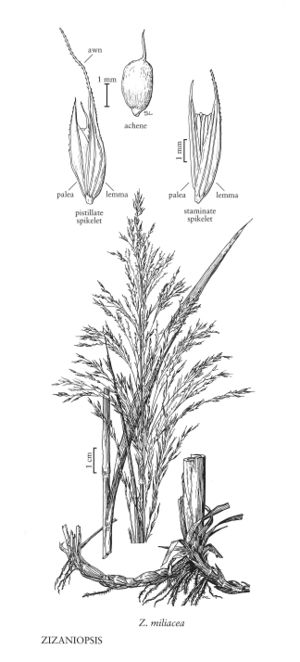Difference between revisions of "Zizaniopsis miliacea"
imported>Volume Importer |
imported>Volume Importer |
||
| Line 40: | Line 40: | ||
|publication year= | |publication year= | ||
|special status= | |special status= | ||
| − | |source xml=https://bitbucket.org/aafc-mbb/fna-data-curation/src/ | + | |source xml=https://bitbucket.org/aafc-mbb/fna-data-curation/src/200273ad09963decb8fc72550212de541d86569d/coarse_grained_fna_xml/V24/V24_58.xml |
|subfamily=Poaceae subfam. Ehrhartoideae | |subfamily=Poaceae subfam. Ehrhartoideae | ||
|tribe=Poaceae tribe Oryzeae | |tribe=Poaceae tribe Oryzeae | ||
Latest revision as of 16:24, 11 May 2021
Plants perennial; rhizomatous, rhizomes to 1.5 cm thick. Culms 1-4 m tall, to 3.5 cm thick, erect or decumbent, glabrous, readily rooting at the nodes when decumbent and producing leafy buds. Sheaths thick, glabrous; ligules to 2 cm, glabrous; blades to 1 m long, 6-30 mm wide, sometimes scabrous, bluish-green, margins scabrous. Panicles to 80+ cm long, usually 4-20 cm wide, open; pedicels to 10 mm long, apices 0.1-0.4 mm wide. Staminate lemmas 5-10 mm, lanceolate to elliptic, glabrous, acuminate or awned, awns to 2 mm; paleas acuminate or awned, awns to 1 mm; anthers 2.5-5 mm. Pistillate lemmas 4-8 mm, ovate or elliptic, awned, awns to 9 mm; paleas caudate-acuminate or awned, awns to 1 mm; style bases 1-3 mm, stigmas 2-6 mm, conspicuously exserted. Achenes 2.5-4 mm long, 1-2 mm wide, ellipsoid or obovoid, smooth, lustrous, beaked by the persistent style base. 2n = 24.
Distribution
Md., Okla., Miss., Tex., La., Mo., Ala., Tenn., N.C., S.C., Va., Ark., Ill., Ga., Ky., Fla.
Discussion
Zizaniopsis miliacea grows in shallow, fresh- or brackish-water marshes, swamps, streams, lakes, and ditches. It is most common on the eastern coastal plain of the United States, extending south to Florida and west to Illinois, Oklahoma and Texas. It has also been reported growing as a disjunct in central Mexico (McVaugh 1983).
Fox and Haller (2000) found that decumbent flowering culms readily produce roots and axillary shoots at the nodes. The decumbent culms act as functional stolons, allowing for rapid colonization; thus plants become established up to 3-4 m away from the parent plant.
Selected References
None.
